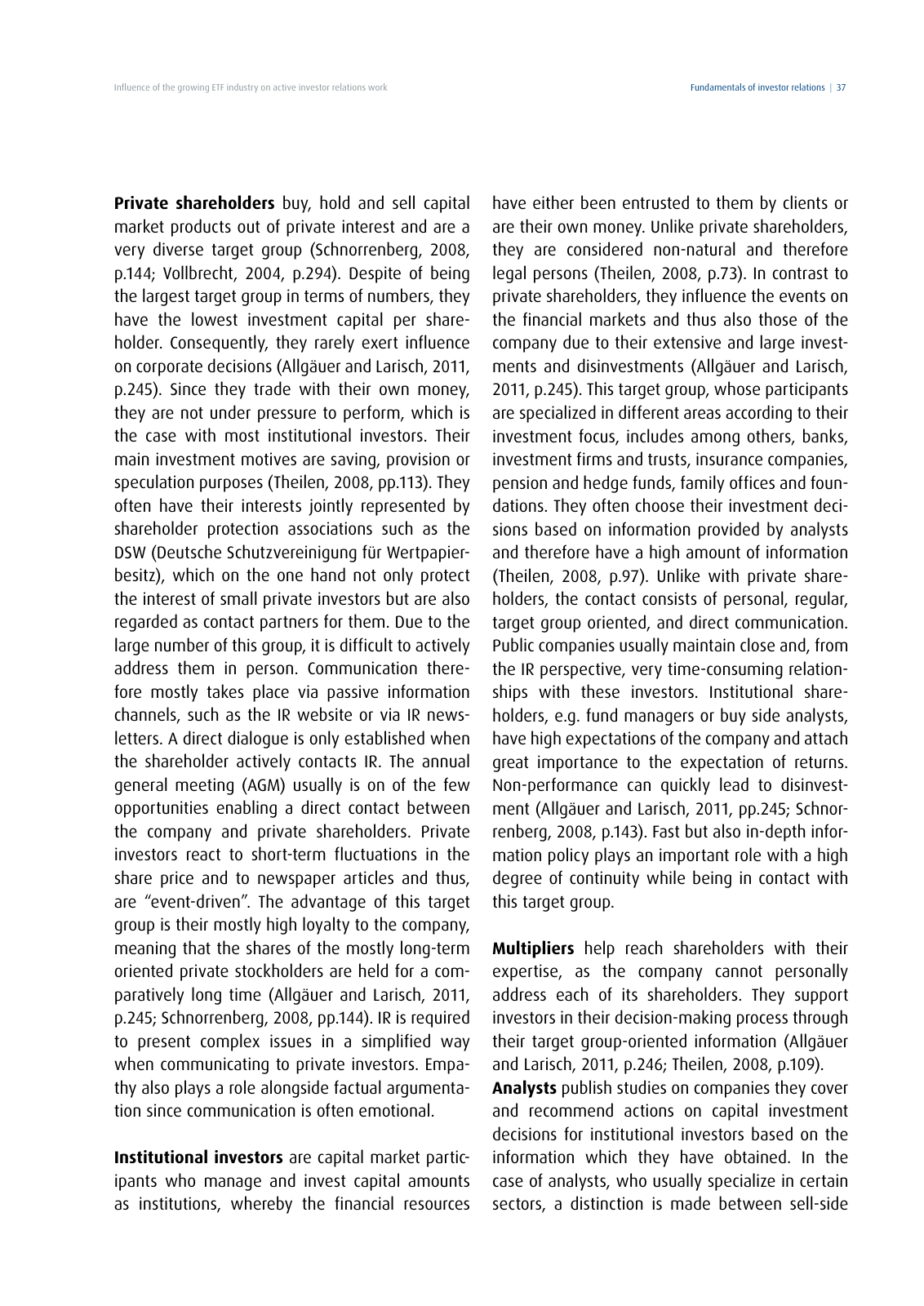Influence of the growing ETF industry on active investor relations work 37 Private shareholders buy hold and sell capital market products out of private interest and are a very diverse target group Schnorrenberg 2008 p 144 Vollbrecht 2004 p 294 Despite of being the largest target group in terms of numbers they have the lowest investment capital per share holder Consequently they rarely exert influence on corporate decisions Allgäuer and Larisch 2011 p 245 Since they trade with their own money they are not under pressure to perform which is the case with most institutional investors Their main investment motives are saving provision or speculation purposes Theilen 2008 pp 113 They often have their interests jointly represented by shareholder protection associations such as the DSW Deutsche Schutzvereinigung für Wertpapier besitz which on the one hand not only protect the interest of small private investors but are also regarded as contact partners for them Due to the large number of this group it is difficult to actively address them in person Communication there fore mostly takes place via passive information channels such as the IR website or via IR news letters A direct dialogue is only established when the shareholder actively contacts IR The annual general meeting AGM usually is on of the few opportunities enabling a direct contact between the company and private shareholders Private investors react to short term fluctuations in the share price and to newspaper articles and thus are event driven The advantage of this target group is their mostly high loyalty to the company meaning that the shares of the mostly long term oriented private stockholders are held for a com paratively long time Allgäuer and Larisch 2011 p 245 Schnorrenberg 2008 pp 144 IR is required to present complex issues in a simplified way when communicating to private investors Empa thy also plays a role alongside factual argumenta tion since communication is often emotional Institutional investors are capital market partic ipants who manage and invest capital amounts as institutions whereby the financial resources have either been entrusted to them by clients or are their own money Unlike private shareholders they are considered non natural and therefore legal persons Theilen 2008 p 73 In contrast to private shareholders they influence the events on the financial markets and thus also those of the company due to their extensive and large invest ments and disinvestments Allgäuer and Larisch 2011 p 245 This target group whose participants are specialized in different areas according to their investment focus includes among others banks investment firms and trusts insurance companies pension and hedge funds family offices and foun dations They often choose their investment deci sions based on information provided by analysts and therefore have a high amount of information Theilen 2008 p 97 Unlike with private share holders the contact consists of personal regular target group oriented and direct communication Public companies usually maintain close and from the IR perspective very time consuming relation ships with these investors Institutional share holders e g fund managers or buy side analysts have high expectations of the company and attach great importance to the expectation of returns Non performance can quickly lead to disinvest ment Allgäuer and Larisch 2011 pp 245 Schnor renberg 2008 p 143 Fast but also in depth infor mation policy plays an important role with a high degree of continuity while being in contact with this target group Multipliers help reach shareholders with their expertise as the company cannot personally address each of its shareholders They support investors in their decision making process through their target group oriented information Allgäuer and Larisch 2011 p 246 Theilen 2008 p 109 Analysts publish studies on companies they cover and recommend actions on capital investment decisions for institutional investors based on the information which they have obtained In the case of analysts who usually specialize in certain sectors a distinction is made between sell side Fundamentals of investor relations

Hinweis: Dies ist eine maschinenlesbare No-Flash Ansicht.
Klicken Sie hier um zur Online-Version zu gelangen.
Klicken Sie hier um zur Online-Version zu gelangen.